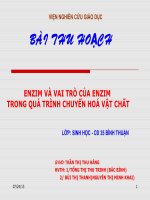en CCNAS v11 ch04 implementing firewall technologies
Bạn đang xem bản rút gọn của tài liệu. Xem và tải ngay bản đầy đủ của tài liệu tại đây (3.49 MB, 136 trang )
Implementing Firewall Technologies
© 2012 Cisco and/or its affiliates. All rights reserved.
1
Firewalls
•
Network firewalls separate protected from non-protected areas preventing unauthorized users from accessing
protected network resources.
•
Technologies used:
–
ACLs
•
–
–
Standard, extended, numbered and named ACLs
Advanced ACLs
•
Stateful firewall - ACLs with the established keyword
•
Reflexive (dynamic) ACLs, timed-based ACLs
Zone-Based Firewall Feature
© 2012 Cisco and/or its affiliates. All rights reserved.
2
Common Types of Firewalls
•
Packet-filtering firewall
•
Stateful firewall
© 2012 Cisco and/or its affiliates. All rights reserved.
3
ACLs
© 2012 Cisco and/or its affiliates. All rights reserved.
4
ACL Types
•
Virtually any type of traffic can be defined explicitly by using an appropriately Numbered ACL.
1-99
, 1300-1999
100-199
•
In the past, the Ethernet type field of an Ethernet frame header was used to define certain types of traffic.
–
•
, 2000-2699
For example, Ethernet type 0x0806 indicated an ARP frame, 0x8035 indicated a RARP frame, ...
It was also common to create ACLs based on MAC addresses.
© 2012 Cisco and/or its affiliates. All rights reserved.
5
Standard ACLs
•
Note:
–
Can be applied in an incoming or outgoing direction on an interface using the ip access-group command.
–
It can also be applied on a VTY port using the access-class command.
© 2012 Cisco and/or its affiliates. All rights reserved.
6
Standard ACLs
•
Create a standard named ACL on R1 called RESTRICT-VTY that permits Telnet access to only the administrative
host.
R1(config)# ip access-list standard RESTRICT-VTY
R1(config-std-nacl)# remark Permit only Admin host
R1(config-std-nacl)# permit host 192.168.1.10
R1(config-std-nacl)# exit
R1(config)# line vty 0 4
R1(config-line)# access-class RESTRICT-VTY
R1(config-line)# exit
© 2012 Cisco and/or its affiliates. All rights reserved.
7
Extended ACLs
© 2012 Cisco and/or its affiliates. All rights reserved.
8
Extended ACLs - 1
•
Create an extended named ACL called ACL-1, applied incoming on the Fa0/0 interface, that denies the workgroup
server outside access but permits the remainder of the LAN users outside access using the established
keyword.
R1(config)# ip access-list extended ACL-1
R1(config-ext-nacl)# remark LAN ACL
R1(config-ext-nacl)# deny ip host 192.168.1.6 any
R1(config-ext-nacl)# permit tcp 192.168.1.0 0.0.0.255 any established
R1(config-ext-nacl)# deny ip any any
R1(config-ext-nacl)# exit
R1(config)# interface Fa0/0
R1(config-if)# ip access-group ACL-1 in
R1(config-if)# exit
© 2012 Cisco and/or its affiliates. All rights reserved.
9
Extended ACLs - 2
•
Create an extended named ACL called ACL-2, applied outgoing on the Fa0/1 DMZ interface, permitting access to
the specified Web and Email servers.
R1(config)# ip access-list extended ACL-2
R1(config-ext-nacl)# remark DMZ ACL
R1(config-ext-nacl)# permit tcp any host 192.168.2.5 eq 25
R1(config-ext-nacl)# permit tcp any host 192.168.2.6 eq 80
R1(config-ext-nacl)# deny ip any any
R1(config-ext-nacl)# interface Fa0/1
R1(config-if)# ip access-group ACL-2 out
R1(config-if)# exit
The log parameter can be appended to the end of an ACL statement.
permit tcp any host 192.168.2.6 eq 80 log
© 2012 Cisco and/or its affiliates. All rights reserved.
10
Logging
•
When configured, the IOS software compares packets and finds a match to the statement.
•
The router then logs it to any enabled logging facility, such as:
–
the console
–
the internal buffer
–
syslog server
© 2012 Cisco and/or its affiliates. All rights reserved.
11
Logging
•
•
Several pieces of information are logged:
–
Action - permit or deny
–
Protocol - TCP, UDP, or ICMP
–
Source and destination addresses
–
For TCP and UDP - source and destination port numbers
–
For ICMP - message types
Log messages are processed switched on the first packet match and then at five minute intervals after that first
packet match.
© 2012 Cisco and/or its affiliates. All rights reserved.
12
View ACL operation
•
A useful command for viewing access list operation is the show log command.
•
To reset counters, use the clear ip access-list counter [number | name] command.
© 2012 Cisco and/or its affiliates. All rights reserved.
13
ACL Caveats
•
Implicit deny all:
–
•
•
All Cisco ACLs end with an implicit "deny all" statement.
Standard ACL packet filtering:
–
Standard ACLs are limited to packet filtering based on source addresses only.
–
Extended ACLs might need to be created to fully implement a security policy.
Order of statements:
–
ACLs have a policy of first match; when a statement is matched, the list is no longer examined.
–
Ensure that statements at the top of the ACL do not negate any statements found lower.
–
Place specific ACL statements higher in the ACL and more general statements near the end.
© 2012 Cisco and/or its affiliates. All rights reserved.
14
ACL Caveats
•
•
Directional filtering:
–
ACLs can be applied to inbound packets (toward the interface) or outbound packets (away from the interface).
–
Double-check the direction of data that an ACL is filtering.
Special packets:
–
Router-generated packets, such as routing table updates, are not subject to outbound ACL statements on the source router.
–
If the security policy requires filtering these types of packets, inbound ACLs on adjacent routers or other router filter mechanism must
be used.
•
Modifying ACLs:
–
New entries are added to an ACL, are always added to the bottom.
–
Starting with Cisco IOS 12.3, sequence numbers can be used to edit an ACL.
–
The ACL is processed top-down based on the sequence numbers of the statements (lowest to highest).
© 2012 Cisco and/or its affiliates. All rights reserved.
15
ACL Sequence Numbers
•
The default behavior when adding a statement to an ACL is that the statement is added to the end. Without
sequence numbers the only way to add a statement between existing entries was to delete the ACL and recreate
it.
•
•
Likewise, the only way to delete an entry was to delete the entire ACL and recreate it.
•
This feature is not available on old-style numbered access lists, which existed before named access lists. Keep in
mind that you can name an access list with a number, so numbers are allowed when they are entered in the
standard or extended named access list configuration mode using the ip access-list {standard |
extended} access-list-name command.
IP access list sequence numbers allow you to selectively remove a statement from an existing ACL or to add a
new statement at any position within the ACL.
© 2012 Cisco and/or its affiliates. All rights reserved.
16
I don’t see my sequence numbers!
•
Sequence numbers are not nvgened. That is, the sequence numbers themselves are not saved. Therefore,
sequence numbers are not displayed in the show running-config or show startup-config output.
•
To view the sequence numbers, use the show ip access-lists access-list-name command or the show
access-list command.
•
By default sequence numbers start at 10 and are incremented by 10 if a sequence number is not specified when
adding statements.
© 2012 Cisco and/or its affiliates. All rights reserved.
17
Modify an ACL using Sequence Numbers
•
First use the show command to view the existing sequence numbers.
R1# show access-list 150
Extended IP acess list 150
10 permit tcp any any eq www
20 permit tcp any any eq telnet
30 permit tcp any any eq smtp
40 permit tcp any any eq pop3
50 permit tcp any any eq 21
60 permit tcp any any eq 20
•
Resequence if necessary.
•
Use the no sequence-number command to delete a statement.
•
Use the sequence-number {permit | deny} command to add a statement within the ACL.
R1(config)# ip access-list extended 150
R1(config-ext-nacl)# no 20
R1(config)# ip access-list extended 150
R1(config-ext-nacl)# 20 permit tcp host 192.168.1.100 any eq telnet
© 2012 Cisco and/or its affiliates. All rights reserved.
18
ACL Placement
© 2012 Cisco and/or its affiliates. All rights reserved.
19
Inbound ACL Operation Flow
© 2012 Cisco and/or its affiliates. All rights reserved.
20
Outbound ACL Operation Flow
© 2012 Cisco and/or its affiliates. All rights reserved.
21
ACL Placement
•
Standard ACL placement:
–
Standard ACLs are placed as close to the destination as possible.
–
Standard ACLs filter packets based on the source address only so placing these ACLs too close to the source can adversely affect
packets by denying all traffic, including valid traffic.
•
Extended ACL placement:
–
Extended ACLs are placed on routers as close to the source as possible that is being filtered.
–
Placing Extended ACLs too far from the source is inefficient use of network resources because packets can be sent a long way only to
be dropped or denied.
© 2012 Cisco and/or its affiliates. All rights reserved.
22
Where to place a Standard ACL?
© 2012 Cisco and/or its affiliates. All rights reserved.
23
Where to place a Extended ACL?
© 2012 Cisco and/or its affiliates. All rights reserved.
24
Configuring ACLs using CCP
© 2012 Cisco and/or its affiliates. All rights reserved.
25









